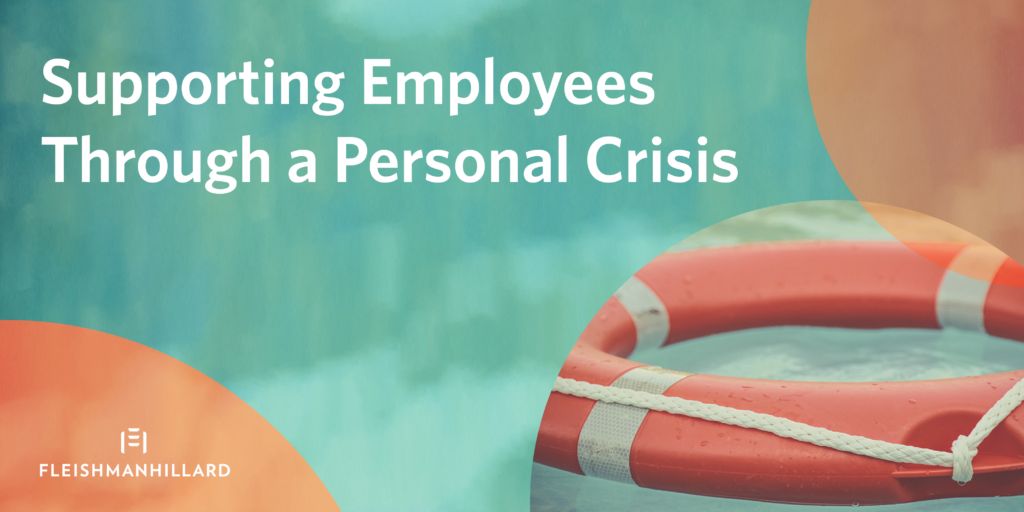Supporting Employees Through a Personal Crisis
When a personal crisis strikes, even employees with the best work-life boundaries can find themselves struggling to stay afloat amidst the storm they’re experiencing. And at some point in your career, you’ll likely be called to support a team member through these murky waters.
Be it a death in the family, severe illness, miscarriage, medical diagnosis, or other event, when things go awry in an employee’s personal life, how you and your organization respond can make a big difference in that individual’s (as well as observers’) employee experience.
Having supported my husband through a cancer diagnosis, reoccurrence, and corresponding treatment twice in the last three years, I’m all too familiar with this. With the benefit of hindsight, there are a few things I’ve learned that can help organizations in supporting their employees through a personal crisis.
1) Synthesize and share benefits information. While your organization may offer a host of benefits that could support an employee through a difficult time, combing through a benefits site to locate or better understand the offering requires the mental capacity that most won’t have in the middle of a life-altering event or diagnosis.
Managers can simplify this process by connecting with HR representatives to understand what benefits are available and most helpful to the employee’s specific situation. Doing this will help engage the right business partner(s) and make an already daunting process seem less overwhelming to the impacted employee.
As you relay options for leave, emotional well-being or mental health support, fertility benefits, employee advocacy programs, etc., take some of the work off the impacted employee’s shoulders by addressing head-on what they’re eligible for, what is needed to use a relevant benefit, and who is their point-of-contact for each benefit.
Particularly for those who are on short- or long-term leave, ensure that you – and the team member – know what documentation requirements exist and communicate any known deadlines for end of coverage, paperwork submissions, etc. to minimize added stress during the actual leave period.
2) Let the impacted employee dictate how much of their situation is shared. I’ve personally found being transparent with team members about my situation as the best approach to ensuring business continuity despite periods of increased absence from work or need for additional flexibility. However, that should not be the expectation of all employees going through a tough time.
If you’re the employee’s manager and they’ve shed light on what’s happening, ask them explicitly when – if at all – it’s appropriate to share what’s going on with other colleagues and/or clients, and what level of detail they’re comfortable with you sharing.
When in doubt, err on the side of caution and stick to “[NAME] is [OUT OFFICE UNTIL WHEN, WORKING A DIFFERENT SCHEDULE FOR THIS TIME PERIOD, ETC.] due to personal circumstances.” and do not budge if probed for more information without explicit permission.
3) Show your humanity. Whether you know details of a teammate’s circumstances or not, small acts of support and kindness go a long way. We spend so much of our lives with our co-workers. If a teammate’s situation is known, silence can cause them to question the work community that they’re investing so much of their time and effort into.
A few of the most memorable human-centric moments I’ve experienced were:
- Managers who remembered big appointment dates and sent encouraging texts ahead of those.
- Teammates who took on extra tasks, calls or assignments without grumbling and often at the drop of a hat when a new “bad news” call or appointment popped up.
- Teammates who sent “thinking of you” cards, texts and emails – I know your time is valuable, so the thought does count.
- Teammates who supported our family with contributions to fundraisers, meal trains, gas and travel money, etc.
- Co-workers who asked how things were going instead of assuming I didn’t want to talk about it.
4) Support a slower or flexible re-entry period. For employees who have been on leave or working a sporadic schedule, don’t expect them to be back to 100% on their first day – or week – back to regularly scheduled programming.
As a manager, ensure their workload is still distributed for the first week (or more) of re-entry. If appropriate and assuming the requests have been handled, assure them they don’t need to address the overwhelming amount of unread emails they probably have in their inbox.
Respect that life has likely drastically changed for your teammate and give them the space to process that transformation however needed.
At the end of the day, empathetic leadership and giving grace can go a long way. Balancing work and life is always hard, but when tragedy strikes, priorities will likely skew toward “life.” At a time when more employees are asking for their whole self to be prioritized by their employer, how you respond and support them through a personal crisis can have a major impact on their morale, engagement and perception of your organization as a whole.

